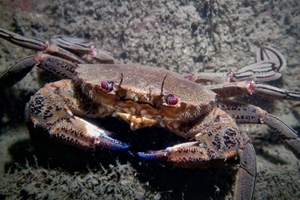Velvet swimming crab
 The British Isles are home to 65 species of crab, some of which will be familiar to those of us whose childhood visits to the coast featured a reel of string, a hag stone, a rasher of bacon and a bucket of seawater. It has been a long time since I went ‘crabbing’, but I might have a go this summer for old times’ sakes, to see if I can encounter the devil-eyed, feisty velvet swimming crab (Necora puber).
The British Isles are home to 65 species of crab, some of which will be familiar to those of us whose childhood visits to the coast featured a reel of string, a hag stone, a rasher of bacon and a bucket of seawater. It has been a long time since I went ‘crabbing’, but I might have a go this summer for old times’ sakes, to see if I can encounter the devil-eyed, feisty velvet swimming crab (Necora puber).
The largest and fastest of our swimming crabs, the velvet crab has specially adapted paddle-shaped back legs allowing it to propel through the water at speed, and it is covered in velvety, downy hair. This furry exoskeleton gives it a beige, sandy appearance, but underneath it has striking patterns which show up on its legs and claws rather like dark tattoos. The carapace (round bit of the body) reaches around 4 inches in width. Its slim but powerful claws are a stunning shade of lapis lazuli blue, and it has bright red eyes, earning it another nickname of devil crab.
Velvet crabs live in shore and rockpool crevices, and amongst weeds and rocks. They can be found from the shoreline right out to a depth of 60-80m and are quite sedentary, never moving more than a hundred metres or so from their home habitat. Here they browse on brown algae, and hunt for hermit crabs, prawns, small fish and marine molluscs. Their claws, not quite capable of the clam-cracking power of the larger crabs and crustaceans, are designed to patiently nip little pieces out of shelled prey.
Like other crustaceans, crabs have to go through moulting, whereby their hard exoskeleton falls off and is replaced by a softer version underneath that hardens over time. In spring and summer this coincides with breeding time, because the female has to be in moult in order to mate. A male will sometimes proactively capture a female and cradle her underneath his body until she moults. Nice to know she has a choice in the matter!
This crab has a reputation for being particularly crabby (excuse the pun). A scuba-diving website describes their behaviour as “unlikely to do harm, but will have a go nonetheless”. Known as the fighter crab to fishermen, they do not take kindly to disturbance above or below the water, moving with surprising speed and nipping with ferocity. Most crab species can be handled if you grasp them either side of the carapace, which ensures the crab can’t reach you with its claws, and after some feeble protest, they usually just give up and let their legs hang. Not this one, though – the velvet crab has fury and skill, and it can contort itself to deliver an eyewatering pinch.
To be fair, if I thought I was going to be eaten I would put up a heck of a fight, and its fears are not unfounded: we do eat this species in considerable quantities in Europe.
Though fiddlier to prepare than the larger edible brown crab (Cancer pagurus), velvet crab meat is apparently very delicious. They are caught in crab fisheries in Cornwall, Northern Ireland and Scotland largely as pot bycatch alongside edible brown crabs, though in some areas they are specifically targeted. Thousands of tonnes of velvet crabs are exported live in lorries to France and Spain, where there is a buoyant market for them. Here’s a slightly illogical scenario: next time you’re enjoying a seafood platter in the southern Mediterranean, there’s every chance the crab you’re eating is from British home waters!
Luckily, the British velvet crab fisheries are considered sustainable by the Marine Conservation Society, and there are rules surrounding the return of smaller crabs and egg-carrying (‘berried’) females. Velvet crabs have a good reproduction rate, with up to 250,000 eggs produced per female per season. They are thought to live around five years in the wild, so there’s a good chance a female can release a million hopeful offspring in her lifetime.
So there we have a glimpse of the life of a feisty, fecund and commercially important crustacean, whom I have come to healthily respect. Better take glove protection if I am going to try to encounter one during my next crabbing trip!
Jess Brooks
Advisory
Photo credit: Portosub